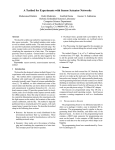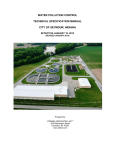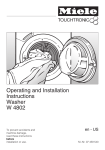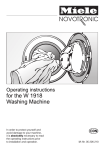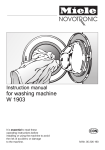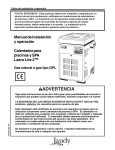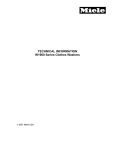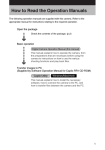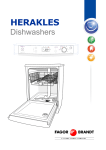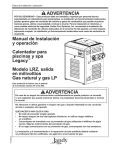Download XL-3 Oil-Fired Pool Heater
Transcript
Installation, Operation and Service Instructions Installation, Operation and Service Manual for the XL-3 Oil-Fired Pool Heater Models DP2000 and DP3000 FOR YOUR SAFETY: This product must be installed and serviced by a professional service technician, qualified in pool heater installation and maintenance. Improper installation and/or operation could create carbon monoxide gas in flue gases which could cause serious injury, property damage, or death. Improper installation and/or operation will void the warranty. WARNING If the information in this manual is not followed exactly, a fire or explosion may result causing property damage, personal injury or loss of life. Do not store or use gasoline or other flammable vapors and liquids in the vicinity of this or any other appliance. WHAT TO DO IF YOU SMELL GAS • Do not try to light any appliance. • Do not touch any electrical switch; do not use any phone in your building. • Immediately call your gas supplier from a nearby phone. Follow the gas supplier's instructions. • If you cannot reach your gas supplier, call the fire department. H0223500- Installation and service must be performed by a qualified installer, service agency, or gas supplier. Page 2 TABLE OF CONTENTS SECTION 1. General Information SECTION 4. Maintenance 1A. 4A. 4B. 4C. 4D. 4E. 4E-1. Warranty ....................................................... 3 SECTION 2. Assembly & Installation 2A. 2B. 2C. 2D. 2D-1. 2D-2. 2D-3. 2E. 2F. 2F-1. 2G. 2H. 2I. 2J. 2K. Shipping Damage ......................................... 3 Assembly and Location ................................ 3 Outdoor Installation ....................................... 5 Indoor Installation .......................................... 5 Venting ......................................................... 5 Clearances .................................................... 6 Combustion Air Supply .................................. 6 Oil Piping ...................................................... 6 Water Piping ................................................. 8 Water Connections ........................................ 8 Pressure Relief Valve .................................... 9 Automatic Chlorinators .................................. 9 Electrical Wiring ............................................ 9 Time Clock Installation ................................ 10 Special Pressure Switch ............................. 10 SECTION 3. Operating Instructions 3A. 3B. 3C. 3D. Start Up Procedure ..................................... 10 Setting the Time Clock ............................... 11 Winter Shutdown ........................................ 12 Periodic Maintenance ................................. 12 4E-2. 4E-3. 4E-4. 4E-5. Trouble-Shooting ........................................ 12 Cleaning the Heat Exchanger .................... 13 Trouble-Shooting Guide ............................. 13 Operating Sequence ................................... 14 Trouble-Shooting ........................................ 14 Burner will not start (motor and transformer do not come on) ...................... 14 Burner Tries to Start, but the Primary Control 10 Shuts Off (either motor or transformer or both come on) ..................... 15 Oil Burner Will Not Shut Off ....................... 15 Setting the Correct Fuel-Air Mixture ........... 15 Regular Maintenance ................................. 16 SECTION 5. Service Information 5A. 5B. Control and Cad Cell Tests ........................ 17 Control & Cad Cell Trouble-Shooting Guide ............................. 17 SECTION 6. Parts List for Model DP Oil-Fired Heater 6A. Parts List .................................................... 18 Model DP Oil-Fired Heater SECTION 1. General Information NOTICE TO INSTALLER: Deliver all documents that come with the heater to the pool owner. These include the Owner’s Information and Operating Manual and this Installation Manual. For your safety, do not store gasoline or other flammable liquids or vapors in the vicinity of this or any other appliance. Page 3 masonry must be laid with ends unsealed and joints matched to provide a free circulation of air through the masonry. Maintain the minimum clearances to combustible surfaces as specified in Sections 2C and 2D of this manual. The heater must be level. The XL-3 is shipped with the inner stack packaged on top of the control panel door in the box with the heater. The inner stack must be assembled and installed before mounting the vent cap or vent Use only #2 fuel oil or #2 diesel fuel. Heavier fuels will not operate satisfactorily, and their use will void the warranty. NOTE: Read the Owner’s Information Manual before starting this installation, and before starting up the heater the first time. 1A. Warranty The XL-3 pool heater is sold with a limited warranty. Details are specified on the back page of this manual. Make warranty claims to an authorized Laars representative or to the factory. Claims must include the serial number and model of the heater, installation date and name of the installer. SECTION 2. Assembly & Installation 2A. Shipping Damage After unpacking the heater, check for visible damage from shipment mishandling. Water Pik Technologies carefully manufactures, inspects and packages the heater before delivering it to the freight carrier. Immediately file any claim for damage against the freight carrier. 2B. Assembly and Location Only use the XL-3 heater with pools filled with potable water. Using the heater with mineral water, salt water, sea water or other non-potable water will void the warranty. The installation must comply with all local building and safety codes. Typically, install the heater on a noncombustible surface. Under Standard NFPA No. 31, it is permissible to install the heater on a combustible surface when the installation complies with the requirements of the American Insurance Association. These requirements specify that the surface under the heater must be hollow masonry not less than 4" thick, covered with at least 24 gauge sheet metal. The DP-2000: 22½" DP-3000: 26¾" Figure 1. XL-2 Oil-Fired Heater. Page 4 Figure 2. Non-Combustible Platform. Figure 4. Inner Stack. pipe. To assemble the inner stack, remove the tape and small envelope from the sheet metal coil. Expand the coil until the holes on each end are aligned. Use the two screws supplied in the small envelope to secure the ends together. Install the inner stack, 7" (18cm) diameter, on the collar of the flue collector before attaching the vent cap (outdoor installation) or vent pipe (indoor installation) as shown in Fig. 4. The XL-3 can be installed with the water connections on either side. Water Pik Technologies ships the heater with the water connections on the right side, but changing the connections to the left side could simplify the installation or improve access for service and maintenance. Make the change before locating and connecting the heater. Follow these step-by-step instructions and Figure 3 to reverse the heat exchanger: 1. Remove the control compartment door. 2. Remove the chimney cap assembly, or barometric draft control if one is installed, and the inner stack (1). 3. Remove the eight screws securing the top assembly (2) and lift off. 4. Bend back retaining tabs and lift out the wire guard (3). Take off the four V-baffles (2 each side). 5. Lift out the flue collector assembly (4). 6. Remove the siphon loop cover (5) located on the right side of the heater under the In-Out header. 7. Remove both gap spacers (6). Figure 3. Heat Exchanger Reversal. 8. Disconnect the siphon loop on the header (7). Remove both drain cocks (8) (one at each end of the heat exchanger). Model DP Oil-Fired Heater Page 5 9. Lift off both heat exchanger baffles. 10. Carefully remove the insulation at each corner of the heat exchanger; it will be re-used. Remove the four hold-down screws (10). 11. Unplug the electrical connector at the switch box inside the control compartment. At the other end of the conduit, loosen the brass compression fitting one or two turns. Rotate the conduit assembly and lay it on top of the heat exchanger. FOR YOUR SAFETY: It is recommended that two people perform the next step. 12. Lift out and rotate the heat exchanger. Make sure the insulation strips stay in position under the header bars. 13. Put the screws through the hold-down clips at each corner of the heat exchanger. Put the insulation back in the corners. 14. Rotate the conduit assembly and attach it to the switch box. Tighten the compression nut on the other end. 15. Replace the heat exchanger baffles and the flue collector assembly. 16. Install the drain cocks and pipe plug according to the illustration (see Fig. 5). 17. Straighten the siphon loop tubing and connect it to the header where the drain plug was removed. 18. Replace the gap spacers, siphon loop cover and rubber plugs and grommets. 19. Install the T-baffles on the gap spacers to match the screw holes in the top assembly. 20. Replace the wire guard. Bend the tabs to secure it in place. Figure 6. Minimum Clearances, Outdoor Installation. 22. Install the chimney cap assembly, or barometric draft control if one was removed. 2C. Outdoor Installation Install the Laars XL-3 heater in the open, or in an enclosure without a roof. The chimney cap supplied with the heater must be installed. The danger of fire requires a minimum clearance from combustible surfaces or shrubbery of 6 inches (15cm) (see Fig. 6). The flue products must be dispersed in the outside air, and fresh air available for proper combustion. Do not install the heater under eaves where roof drainage could fall directly on the heater. It is possible that prevailing winds could cause a downdraft. Therefore, keep the side of the heater at least 3 feet (91 cm) from the face of any wall or fence. 2D. Indoor Installation 2D-1. Venting If the heater is installed in an occupied building, 21. Attach the top assembly. Install the inner stack Figure 5. Connection Locations. Figure 7. Incorrect Installation. Page 6 Figure 8. Venting, Indoor Installation. the room containing the heater must have its own combustion and ventilation openings as described below (see Fig. 8). Vent the XL-3 to a permanent chimney or through the roof with an approved stack when it is installed indoors. You must install a barometric draft control between the heater and the stack with a minimum 13" clearance between the chimney connector and any combustible surface. Observe NFPA Standard No. 31 and all national and local ordinances. Run the vent pipe as directly as possible with minimum turns. Never use a vent smaller than 9" (23cm). On lateral runs, maintain a minimum pitch of 1/4" (.6cm) per linear foot. If a chimney is used, the total equivalent straight length of flue piping between the heater and the chimney should not exceed 75% of the vertical height of the chimney above the flue pipe connection. The chimney should be at least 9" (23cm) diameter. Maintain adequate clearances between the vent pipe and combustible materials. Check local codes and the vent manufacturer’s instructions for proper clearances. The 7" (18cm) dia. inner stack must be in place. Any change in the amount of draft in the combustion chamber can affect the flame characteristics. An approved barometric draft control must be used on all indoor installations to maintain a clean and consistent flame. When the system is properly adjusted, the pressure in the stack below the draft control will be approximately minus .03" W.C. If this draft pressure cannot be achieved, the chimney is too short or too small. Take corrective action. Avoid locating the chimney termination in a location susceptible to down draft conditions, or near ventilation inlets to the building. 2D-2. Clearances Provide the following minimum clearances from combustible surfaces: Water Inlet/Outlet side Other side and rear Front Control compartment Chimney connector 24" 6" 24" 13" (61cm) (15cm) (61cm) (33cm) 2D-3. Combustion Air Supply Do not install the heater in a room that does not have enough air supply to support combustion. There must be two openings to outside air provided; each opening must have a free area equal to 80 sq. in. (516.1 sq. cm). It is good practice to put one opening near the floor and the other near the ceiling. When installing the heater in an interior room, all doors communicating with outside air must have specified openings (see Fig. 9). There must be no Model DP Oil-Fired Heater Page 7 Figure 9. Combustion Air, Indoor Installation. openings communicating with living areas. 2E. Oil Piping All XL-3 heaters are equipped with two-stage fuel units. Water Pik Technologies recommends a two-pipe system with a supply line and a return line between the heater and the tank (see Fig. 10). When using a two-pipe system, install the bypass plug in the fuel unit. The plug is shipped in the small plastic bag attached to the oil burner. The location for the plug is shown on the decal on the end of the fuel unit. Remove the large hex-head fitting and insert the plug, Lift from bottom of Storage tank to fuel unit Total Tubing 3/8" dia. Length Allowed 1/2" dia. 0 2 4 6 8 10 12 14 16 18 68 ft. (20.7m) 63 ft. (1 9.2m) 58 ft. (17.7m) 53 ft. (16.2 m) 48 ft. (14.6m) 42 ft. (12.8m) 37 ft. (11.3m) 32 ft. ( 9.8m) 27 ft. ( 8.3m) 22 ft. ( 6.7m) 100 ft. (30.5m) 100 ft. (30.5m) 100 ft. (30.5m) 100 ft. (30.5m) 100 ft. (30.5m) 100 ft (30.5m) 100 ft. (30.5m) 100 ft. (30.5m) 100 ft. (30.5m) 88 ft. (26.8m) ft. ft. ft. ft. ft. ft. ft. ft, ft. ft. (0.0m) (0.6m) (1.2m) (1.8m) (2.4m) (3.0m) (3.7m) (4.3m) (4.9m) (5.5m) Table 1. Fuel Line Sizes. Figure 10. One-Pipe and Two-Pipe Systems. Page 8 Figure 11. Oil Filter Installation. Figure 13. Thermometer Placement. using an Allen wrench. Check the instructions attached to the fuel pump for proper fuel connections. Compression fittings are not recommended. See Table 1 for correct fuel line sizes. NEVER USE TUBING SMALLER THAN 3/8" (1cm). Water Pik Technologies provides an oil filter with the XL-3 heater. Install this filter using the fittings provided for convenient servicing of the oil burner and filter (see Fig. 11). Post a notice near the heater stating filter service frequency. Provide an approved, high quality shutoff valve at the oil supply tank. universal flange couplings on the heater as shown below. The inlet and outlet ports on the heater are clearly marked with arrows on top of the control cover. The flanged couplings accept either threaded iron pipe, 1-1/2" NPT, unthreaded 1-1/4" iron pipe, or 1-1/2" copper tubing (see Fig. 12). Connect the pool heater between the pump and filter and the pool or spa. If the system flow rate exceeds 60 gpm (228 lpm), install a manual bypass valve between the heater inlet and outlet (see Fig. 15). If the flow rate is below 60 gpm (228 lpm), the automatic, built-in bypass valve will maintain the proper flow through the heater. If a manual bypass is required, adjust it using the following procedure: 2F. Water Piping 2F-1. Water Connections Connect the inlet and outlet piping to the Figure 12. Water Connections. 1. Clean the filter. 2. Install a thermometer in the 1/2" NPT threaded opening in the front header casting as shown in Fig. 13. 3 Close the manual bypass valve. 4. Turn the heater switch to OFF, and run the filter pump. Record the temperature. 5. Turn the heater switch to ON, and turn the thermostat high enough to call for heat. 6. Gradually open the manual bypass valve until the thermometer reads 11 to 14°F (6.1 to 7.8°C) for the DP-2000 or 16 to 20°F (8.9 to 11.1°C) for the DP-3000 above the temperature recorded in Step 4. Model DP Oil-Fired Heater Page 9 The bypass valve is properly adjusted. Remove the handle on the valve, or place a warning tag “DO NOT TOUCH THIS VALVE.” Install a check valve and heat sink pipe in the heater inlet if any part of the piping or filter system uses plastic materials (see Fig. 15). 2G. Pressure Relief Valve 2H. Automatic Chlorinators A concentration of chlorine in the heater can be very destructive. Heater damage caused by high concentrations of chlorine, for any reason, is not covered by the warranty. IMPORTANT: A pressure relief valve is not furnished with the heater, except in Canada. Check local building and plumbing codes to determine if a pressure relief valve is required. A 75 psi rated relief valve is recommended for protection of the filter system if there is a shut-off valve installed between the heater and the pool (see Fig. 14). If a pressure relief valve is not required, leave the standard 3/4" brass plug in place. 1. Provide the automatic chlorinator with an antisiphoning device to prevent chlorine siphoning into the heater after the pump shuts off. 2. Wire the electric chlorinator so it cannot operate unless the filter pump is running. If the chlorinator has an independent clock control, synchronize the filter pump and chlorinator clocks, so the chlorinator only operates during the filter cycle. 3. If the chlorinator is equipped with its own pump, install it so that it introduces the gas or solution downstream from the heater, and at a lower position than the heater outlet. 2I. Electrical Wiring Wire the XL-3 heater in accordance with the National Electric Code and all applicable local codes. The power supply must be 11 5V, 60Hz, single phase with voltage maintained between 104V and 126V. have a double-pole ON/OFF switch (see Fig. 16-17). Run all field-supplied wires in conduit to the knockout at the bottom of the ON/OFF switch box. Figure 14. Pressure Relief Valve. Thermometer For Testing Temperature Rise Manual bypass is used only when filtration rate normally exceeds 60 gallons per minute Figure 15. Water Piping. Page 10 Attach a ground wire to the green lug in the switch box as shown in the wiring diagram. A separate lug is on the exterior of the heater for a system bonding conductor as required by Article 680 of the National Electric Code, ANSI C1 -1975. The XL-3 is factory-wired for a time clock. 2J. Time Clock Installation A time clock which will automatically turn the pool system OFF and ON provides convenience and safety, and is more economical. If a time clock is installed, it is recommended that it include a Fireman Switch. The Fireman Switch will shut down the heater about 20 minutes before the filter pump shuts down. This allows the water flow to carry away residual heat in the firebox without damage to the heater or other parts of the system. Field install high temperature wires (150°C) from the Fireman Switch. Run the wires to the heater through the knockout on the right side of the heater body. Connect them to the two wires joined with a wirenut in the control compartment. The wirenut has a tag on it carrying wiring instructions. Position the field-installed wires away from the inner panel. 2K. Special Pressure Switch A special pressure switch is required if the XL-3 is installed more than 3 feet below the surface of the pool. Consult a Laars representative or contact the factory. IMPORTANT: Before starting the heater on a new installation, relieve all air from the system by running the filter pump for at least 15 minutes. SECTION 3. Operating Instructions DP2000 DP3000 OIL FIRED POOL HEATER 3A. Start-up Procedure In a new installation, always run the filter pump with the heater turned off long enough to completely clean the pool water. This will remove any residue left from construction. Clean the filter before starting the heater. Before starting the oil burner, check the wiring to make sure there are no loose connections. Check all fuel line connections for tightness. Open the fuel shutoff valves at the heater and the tank. Caution Do not try to light the burner if excessive oil has accumulated in the firebox, or when the heater is full of vapors. Figure 16. Wiring Diagram, 60 Hz Model. A QUALIFIED SERVICE TECHNICIAN Model DP Oil-Fired Heater Page 11 (see NOTE below). If a one-pipe system is used, it must be thoroughly purged of air using the vent plug on the oil pump. SHOULD START THE OIL BURNER. Check the operation of the burner. Make sure of the proper air adjustment. Check the flame pattern and temperature. The air shutter is factory set for 12% C02, but verify this after installation. 1. Start the filter pump. Let it run for about five minutes to free any trapped air. 2. Set the thermostat well above the pool water temperature. 3. 4. 5. Turn the heater switch ON. If the burner motor does not start right away, reset the manual overload switches on the motor and primary control. If the motor runs but the burner fails to light, it may be necessary to bleed air from the fuel line. See Step 5. Check the initial air adjustment (see Fig. 17). Normally, the bulk air band (A) and the end air shutter (B) should be partially open. It is factory set for both indoor and outdoor installations, but check it again after completing the installation by measuring the C02, It should be 12% C02 with zero smoke. Set a barometric draft control to give .02" to .03" W.C. draft below the draft control when the heater is installed indoors. When the heater is attached to a two-pipe system, the fuel pump will automatically vent air out of the fuel lines. If there is a lot of air, the primary control may shut the burner down before all the air has been purged. If this happens, wait 2 minutes, then press the reset button on the primary control. Repeat this procedure until all the air has been vented and the unit fires properly IMPORTANT: If there is no ignition after three reset attempts, stop. Check for accumulated oil in the firebox. Remove all unburned oil with dry rags before continuing the restart procedure. If there is no oil accumulated, try three more re-sets. If there is still no ignition, have a qualified oil service technician bleed the fuel line and check for ignition problems. When the heater does fire, oil which is in the firebox will cause considerable smoke as it burns off. 6. Set the thermostat to the desired temperature. Until the pool water reaches a temperature of approximately 70°F (21°C), there may be condensate on the heat exchanger. This will stop after the water reaches the right temperature. NOTE: The firebox in the heater is made from the best high temperature material available. Starches have been added to this material during the molding process. When the heater is first fired, the starches oxidize producing noticeable smoke. This will stop after about an hour of operation. If the heater is installed in an enclosed area, keep all doors and windows open during the first two hours of operation. After a long shutdown, there may be some smoke-like emissions from the heater when it is first fired. This condition will only last a few minutes. 3B. Setting the Time Clock The most economical and trouble-free way of operating a pool heater and filter system is to include a time clock in the system for automatic cycling. Adjust the stops on the time clock to provide a single filter cycle every 24 hours. The ON cycle should be at least 12 hours to allow the filter system to properly clean the pool. Set the ON cycle at least 4 to 6 hours before the pool is to be used. During cold spells, the heater may have to be on longer to maintain the proper pool temperature. Remove all stops on the time clock during these periods. IMPORTANT: Run the heater continuously during the initial warm-up period by removing all time clock stops. If the pool temperature is going to be maintained on standby temperature, operate the filter pump until the water temperature reaches 70°F (21°C). If the pool is going to be used for swimming, bring the water up to swimming temperature before replacing the Figure 17. Initial Air Adjustment. Page 12 time clock stops. When the water reaches the temperature level on the thermostat, the heater will turn off automatically, but the filter pump will continue to run for about 20 minutes. 3C. Winter Shutdown The heater could be seriously damaged by freezing temperatures if it is not properly drained. To shut the heater down for the winter, turn off all electrical power to the heater. Remove both drain cocks or plugs (see Fig. 18). Grease the threads on both the plugs and the holes, and store them in a safe place during the freezing weather. It will also be necessary to remove one end of the pressure switch siphon loop (refer to Fig. 3): 1. Remove the siphon loop cover on the right side of the heater. 2. Remove the compression nut attaching the siphon loop tube near the front of the heater. 3. The siphon loop should drain. NOTE: The XL-3 heater is not designed for continuous use to combat freezing temperatures. Keep the temperature at a minimum 70°F (21°C) or shut the heater down completely. Operating the heater for long periods at or near freezing water temperature can seriously damage the heater, and may create a dangerous condition by fouling the external heat exchanger passages, causing incomplete combustion. 3D. Periodic Maintenance Oil the oil burner motor every six months. Use SAE 30 non-detergent motor oil in both holes. Check the following items at least twice yearly: Wiring Safety Controls Oil Piping Oil Filter Combustion Heat Exchanger for sooting Product Specifications DP-2000 DP-3000 BTU/hr 230,000 315,000 Fuel Consumption 1.65 GPH 2.25 GPH Shipping Weight 285 lbs. 315 lbs. Electrical, Dom. 115 VAC, 60Hz, 1 Ph. Pump Press, Dom. 100 psi SECTION 4. Maintenance 4A. Trouble-Shooting Problems which may come up with the pool heater operation or performance will require a trained, professional technician. There are a few preliminary symptoms the pool owner should check before calling a technician: Oil Burner Does Not Fire 1. Is the pool temperature control set high enough to call for heat? 2. Is the pool heater switch ON? Are all circuit fuses and remote switches ON? 3. Is the pool filter clean? 4. Is there enough fuel in the tank? Is the fuel valve turned ON? If the answer to all of these questions is yes, try the manual overload reset switches on the burner motor and primary control. If burner does not fire, turn the heater switch OFF then ON, and try the reset switches again. If the burner still refuses to fire, call the service technician. Figure 18. Heater Drains. Model DP Oil-Fired Heater Page 13 Heater Does Not Maintain the Desired Water Temperature 1. Remove the heater top assembly and flue collector. 1. Is the temperature control set high enough? 2. Remove the inspection hole cover (see Fig. 19). 2. Is the filter cycle setting on the time clock long enough to permit the heater to raise the temperature? 3. Use an ordinary kitchen brush to brush across the top of the heat exchanger between the tube fins. 3. Is the heater the right size for the pool? See the Installation instructions. 4. Use a bottle brush to brush down between the tube fins toward the firebox. If these conditions are satisfactory, the heat exchanger could be fouled, or the heater controls may not be functioning properly. Call a service technician. Burner Operates, But There is Smoke or Pulsating Combustion This is usually caused by improper combustion adjustment, fouled heat exchanger or a fuel supply problem. Call a service technician. Pool Water Overheating Turn the heater switch OFF and call a service technician. The ash can be softened for easier removal by lightly dampening with a wet brush. Do not let water get in the firebox. 5. Reach through the inspection hole and brush across the bottom of the tube fins using the kitchen brush. 6. Remove all dirt and soot from the firebox by inserting a vacuum cleaner nozzle through the inspection hole. 7. Replace the flue collector and top assembly. 8. For more thorough cleaning, remove the heat exchanger completely and wash it with a garden hose. 4B. Cleaning the Heating Exchanger Caution Black carbon soot on a dirty heat exchanger can, under certain circumstances, be ignited by a random spark or open flame. To prevent this from happening, dampen the soot deposits with a wet brush or fine water spray before servicing or cleaning the heat exchanger. Caution Be careful to avoid damaging the firebox material when cleaning the heat exchanger or inspecting the heater. Keep water out of the firebox. Be sure to replace the gasket, inspection plug and retainer when the cleaning or inspection is complete. 4C. Trouble-Shooting Guide Clean the heat exchanger annually, preferably at the end of the swimming season. Clean as follows: Introduction A qualified oil burner technician should service this equipment. Frequently, this service is available through the fuel oil supplier. Caution Some of these procedures involve exposing the line voltage circuit. There is considerable danger of electric shock. The XL-3 is an oil-fired pool heater designed to burn No. 2 fuel oil or No. 2 diesel fuel. Do not use other fuels. The burner assembly comes standard with a two-stage pump. This allows the heater to be installed a relatively long distance from the fuel tank. Initial Checks 1. Figure 19. Inspection Hole Location. Is the oil burner connected to a one- or two-pipe system? All units are. Factory set for one-pipe systems. To convert a unit to a two-pipe system, Page 14 a bypass plug must be installed in the fuel pump. The plug is supplied with the oil burner. There is a decal located on the fuel pump showing where the bypass plug goes. If a fuel unit is set up for a two-pipe system, but is actually connected to a one-pipe system, the pressure in the fuel pump builds up to over 300 psi when the burner turns on. This will cause the motor to bind and stop running or ruin the pump seals, or both, 2. An oil filter must be installed on the inlet line. A very small amount of dirt in the oil can plug the nozzle. A properly sized oil filter is shipped with the heater (see Fig. 11). 3. Is there oil in the storage tank? 4. Are all of the shut-off valves on the oil lines open? 5. 6. Are the fuel lines adequately sized according to the table on page 5? Are there any leaks in the fuel line? A very small leak can cause the fuel pump to suck air into the system, resulting in failure to operate or a pulsating, noisy fire. 7. Is the unit properly grounded electrically? This is extremely important. Use of PVC piping in the pool filter system prevents grounding through the piping. 8. If a time clock is installed, is there power to the timer? Is the timer motor working? There is usually a visual motor check opening on the timer mechanism. Is the switch located below the timer dial “ON”? 9. Figure 20. Cad Cella and Primary Control. burner will not fire. If everything checks out, the burner motor and ignition transformer are powered. On 60Hz models, the ignition transformer operates during the entire burner operation. 4. If the cad cell does not sense a good flame within 30 seconds the primary control de-energizes the motor and ignition transformer. This turns off the heater. It can be manually restarted by pushing the reset button after waiting about one minute. 5. During the period when the filter pump is running, which is set by the time clock, the thermostat will turn the burner on and off as required to maintain the water temperature set on the thermostat. 6. If a time clock is used, the contacts in the Fireman switch open about 20 minutes before the pool filter cycle is completed. This shuts off the oil burner. The oil burner cannot be restarted during this period. The filter pump continues to run for another 20 minutes, transferring any heat stored in the firebox to the pool. Are there any loose wires or terminals? 10. Is the pool filter clean, and is the pump operating properly? 4D. Operating Sequence When every part of the system is working properly, the heater will go through the following sequence: 1. When the filter pump builds up enough pressure in the piping, the contacts in the heater pressure switch close. 2. The heater thermostat calls for heat completing the circuit between the two thermostat terminals on the primary control of the oil burner. 3. The primary safety control on the oil burner goes through a self-test sequence. One of the steps in the sequence is to check out the cadmium cell flame detector. If the cad cell senses light, the 4E. Troubleshooting NOTE: These troubleshooting procedures require connections to electrical terminals and jumper wires to check operation. To avoid electrical shock, turn off electric power before servicing line voltage controls. Never leave a jumper wire in place to fix a heater. This would bypass safety and operating controls. 4E-1. Burner will not start (motor and transformer do not come on) Model DP Oil-Fired Heater 1. Is there power to the heater? Have you checked the reset buttons on the motor and primary control? 2. Place a jumper wire across the two terminals on the cad cell. If the burner starts, the problem is in the heater control circuit. This circuit consists of the pressure switch, high limit control, safety switch, thermostat, time clock switch (if one is installed) or the wire harness. Check the wire harness for any loose wires or worn insulation. Then jumper each control until the problem is located. 3. 4. Press the reset button on the primary control. If the unit does not start, go to step 5. If the unit starts, turn off the power and check the following items that can lock out the primary control: a. Dirty or defective cad cell (see Page 4). b. Defective primary control (see Page 4). c. Oil level in tank too low or water in the tank. d. Poor combustion caused by: Fouled nozzle Fuel line air leaks Improper nozzle pressure (pressure should be 100 psi) Improper air setting (see part D) Press the reset button on the motor. If the unit does not start, go to step 5. If the unit starts, shut off power and check the blower wheel and flexible coupling between the motor and the fuel pump. Make sure the blower wheel and fuel unit are not binding. Make sure the return fuel line is not restricted. 5. Remove one cad cell wire from the primary control. If the burner starts, replace the cad cell. 6. Turn off electric power to the heater. Short out the high limit switch, in the high voltage circuit. If the burner starts when power is restored, the switch is faulty. 7. 8. Turn off electric power and inspect the wiring below the primary control and the ignition transformer. Make sure there are no loose connections. If the wiring is okay, and the blower wheel rotates freely, replace the primary control. 4E-2. Burner Tries to Start, but the Primary Control 10 Shuts Off (either motor or transformer or both come on) 1. Is the burner motor turning? If yes, go to next step. 2. Press the reset buttons on the motor and primary control. If the motor does not start, but Page 15 transformer is providing spark at the electrodes, go to step 3. 3. Lift the ignition transformer and make sure the motor rotates freely. If it does not rotate freely, replace the motor. If the motor is internally binding, replace the motor. 4. Open the inspection port and use a mirror to check combustion. If there is no ignition before the primary control shuts the burner down, go to step 6. If the burner does ignite with a good flame, go to step 5. If the burner tries to ignite, but the flame is intermittent, go to step 8. 5. Check the cad cell and primary control. 6. Lift up the ignition transformer and put tape over the front of the cad cell (the burner will not start unless the cad cell senses no light). Disconnect the black lead going to the motor. Press the primary control reset button. Use an insulated screwdriver to touch the metal blade to one spring contact on the transformer, and about 3/8" away from the other spring contact. If there is good spark between the blade and the spring, go to the next step. If there is no spark, replace the transformer. 7. Remove the electrode-nozzle assembly and inspect the high voltage sections for fouling, cracked insulators or burnt electrodes. Replace any defective parts. 8. If the flame is poor quality or intermittent, use a pressure gauge to check the nozzle pressure. If the pressure is below 100 psi, but steady, reset it to 100 psi and go to step 9. If the pressure is not steady, use the attached Sundstrand Field Service bulletin to check out the fuel unit. An unsteady pressure reading could be a sign of a dirty oil filter. 9. Replace the burner nozzle with the nozzle called out on the heater rating plate and go to step 10. Replace nozzles once a year as part of the annual cleaning and inspection service. 10. Check the C02 Of the flue gases. The reading should be between 11.5 to 12.5%. If the reading is different, go to Section D. 4E-3. Oil Burner Will Not Shut Off Remove one of the thermostat leads from the primary control. If the oil burner shuts off, the problem is in the heater control circuit. The circuit includes the pressure switch, high limit safety switch, thermostat and wire harness. Check for worn insulation on the wire harness, which could cause a short. Check operation of the thermostat and pressure switch. 4E-4. Setting the Correct Fuel-Air Mixture Page 16 Figure 21. Electrode Adjustment. Measure the C02- If it measures less than 11.5%, decrease the air supply. If it measures higher than 12.5%, increase the air supply. When the fuel-air setting is correct, there will be zero smoke. If there are still traces of smoke after adjusting the fuel-air mixture, slowly increase the air supply until the smoke disappears. Use the proper instruments to measure both the smoke and C02. 1. Too Much Air (low C02) Too much air decreases the efficiency of the heater, and causes overheating of the jacket by pressurizing the firebox. Too much air can also cause poor ignition and a pulsating flame. If the C02 reading is below 11.5%, reduce the air adjustment openings on the burner. 2. Not Enough Air (high C02) Not enough air is much easier to detect. The flame is dark yellow and the heater will smoke. Generally, the C02 reading will be above 12 % when not enough air is provided. Lacking proper instruments, a temporary fuel-air adjustment can be made. Close the end shutter and then slowly close the air bank until the heater starts to smoke. Slowly open the end shutter until the smoke completely disappears. The fuel-air mixture will be close to the correct setting. 4E-5. Regular Maintenance 1. At least once during the pool heating season, or every six months, remove accumulated soot from the heat exchanger. Remove the top of the heater and lift out the flue collector. Remove the “T’ baffles (the retaining wire does not have to be replaced). Brush the soot and ash from the spacing between the fins using a brush across the top. Clean the underside through the inspection hole. Use a bottle brush to clean the spacing between the tubes. Remove all of the ash and soot that has fallen to the bottom of the heater with a vacuum cleaner. Model DP Oil-Fired Heater 2. Replace the oil nozzle once a season (see the oil burner Manual). 3. Oil the burner motor every three months. Use non- detergent #40 motor oil at both oil holes. 4. Replace the in-line oil filter cartridge once a year. SECTION 5. Service Information Page 17 c. d. e. f. Attach the cad cell wires to the primary control. Attach the thermostat wires to the primary control. Push the primary control reset button. Set the ohmmeter range to 100 MA when it is not going to be used. 14. Turn the heater thermostat all the way to the right. The burner should start. Reset the thermostat to the appropriate temperature. 5A. Control and Cad Cell Tests IMPORTANT: In the following test procedures: 1. 2. The 2,000 ohm resistor checks the calibration and performance of the primary safety control. The ohm meter checks cad cell operation only. 5B. Control & Cad Cell Trouble-Shooting Guide Symptom Step 2. Possible Cause Burner runs all the time Defective primary control Test Instructions 1. Remove two thermostat wires from the primary control. 2. Push reset buttons on burner motor and primary control. 3. Remove two cad cell wires from primary control. 4. Connect ohmmeter leads to cad cell wires. 5. Set ohmmeter range to 1 KW. 6. Connect resistor wires to cad cell terminals on the Step 2. primary control. 7. Place a jumper wire on the thermostat terminals on the primary control. 8. Loosen one cad cell terminal screw on the primary control. Move the resistor wire slightly to temporarily break contact. When the burner starts, quickly tighten the terminal screw. 9. Check combustion to make sure there is flame. If there is no flame, open the thermostat jumper and stop the test. 10. The ohmmeter pointer should go to zero. If the pointer stops between 2 and 3, that’s okay. 11. After three minutes, remove one 2,000 ohm resistor wire from the primary control. The primary should lock out on safety within 25 seconds, Step 8. No combustion Step 10. Ohmmeter pointer above 2. Ohmmeter pointer below 3 Partly plugged nozzle. Cad cell dirty. Cad cell misaligned. Defective cell. Not enough combustion air. Cad cell sees too much light. Adjust alignment. Step 11. Primary won’t lock out Defective primary Step 12. Ohmmeter pointer below 50 12. After the primary locks out, the ohmmeter pointer should move to near the 50 mark on the scale. 13. Wait three minutes, then perform the following steps in the right order: a. Remove the 2,000 ohm resistor from the primary control. b. Remove the jumper wire from the primary control thermostat terminals. No power to the primary. Limit switch turned off. Defective limit switch. Bad wire connection. Bad burner motor. No power from fuse box. Defective primary Stray light in burner housing. Defective cad cell. Step 14. Burner won’t start Step 14. Open circuit in thermostat wiring. Dirty thermostat contacts. Defective thermostat. Page 18 SECTION 6. Parts List for Model DP Oil-Fired Heater Key No. Description Model ORDER No. PART NO. Key No. Description 49 50 51 51 52 53 54 55 55 56 56 57 58 58 59 60 61 62 62 63 63 1 1 2 3 4 FUEL SYSTEMS Oil Burner Assembly Oil Burner Assembly Oil Filter (Not Shown) Oil Filter Cartridge (Not Shown) 3/8” Oil Line, Pump to Filter 2000 3000 All All All L0060000 L0060100 P0065100 P0065500 10430402 5 6 7 8 9 10 11 12 13 14 15 16 17 18 19 20 21 22 23 ELECTRICAL SYSTEM Thermostat Thermostat Knob Thermostat Dial Thermostat Cover Thermostat Back Thermostat Base Plate Pressure Switch, 1-10 PSI Siphon Loop Cover Siphon Loop Assembly High-Limit Switch Assembly High-Limit Switch, 135°F High-Limit Switch, 150°F High-Limit Switch Harness (115V) High-Limit Switch Harness High-Limit Switch Cover Switch Cover ON/OFF Switch Oil Burner Harness Connector Elbow 90° All All All All All All All All All All All All All All All All All All All R0318800 R0010700 H0048400 10388300 10368000 10362000 R0045400 10403400 R0057800 R0023200 R0022700 R0012700 R0057500 R0057700 10401100 E0078300 E0078200 R0057600 P0059800 24 24 25 25 26 27 28 29 30 30 31 31 32 34 35 36 37 38 39 40 41 42 42 43 44 45 46 47 48 WATER SYSTEMS Heat Exchanger Assembly, Complete Heat Exchanger Assembly, Complete Heat Exchanger Heat Exchanger Inlet/Outlet Header End Cap (1/2” tap) End Cap (No tap) End Cap (1/4” tap) Tee Baffle (5) Tee Baffle (5) End Baffle (2) End Baffle (2) Tube Gaskets (12) Grommet (2 Required) Brass Plug, 3/4” (1) Drain Valve Extension Drain Plug, 1/4” (3) By-Pass Assembly By-Pass Valve Rod By-Pass Valve Disc By-Pass Valve Rod Retainer By-Pass Valve Spring By-Pass Valve Spring Flange & Gasket Assembly Flange, 1 1/2" Flange Gasket, 1 1/2" Flange Sleeve, 1 1/2" Flange Bolt Gasket 2000 3000 2000 3000 All All All All 2000 3000 2000 3000 All All All All All All All All All 2000 3000 All All All All All All 10927101 10927102 10927001 10927002 10403700 10403900 10406100 10403800 10926901 10926902 10387702 10387703 S0063400 S0098800 P0027000 P0059900 P0026800 R0020600 S0074300 S0074200 S0008700 S0061300 S0061300 R0031900 10309200 S0053100 S0028000 F0031700 S0065300 Model ORDER No. PART NO. FIRE BOX & JACKET COMPONENTS Burner Tube Gasket All Burner Support Bracket All Burner Compartment Door 2000 Burner Compartment Door 3000 Fire Box Plug All Fire Box Cover Plate All Gap Spacer (Return) All Flue Collector Assemby All Flue Collector Assemby All Flue Top Assembly 2000 Flue Top Assembly 3000 Inner Stack All Flue Collector Shield 2000 Flue Collector Shield 3000 Vent Blade (10) All Gap Spacer (In/Out) All Hold Down Clip All Fire Box 2000 Fire Box 3000 Fire Box Cover (2) 2000 Fire Box Cover (2) 3000 N0006600 10392000 10412203 10412204 T0020700 10425800 10401000 10406301 10406302 10405001 10405002 10390000 10404501 10405002 10319300 10400900 10401200 T0020500 T0020600 10400801 10400802 OIL BURNER PARTS & COMPONENTS (Not Shown) Air Tube Screw All Pilot Bracket Screw All End Air Shutter All Bulk Air Band All Air Tube Gasket All Motor, 1/7 H.P. , 3450 RPM All Blower Wheel 4- 1/4” x 3- 7/16” All Flexible Coupling All Fuel Unit, Two Stage All Pump Outlet Fitting All Connector Tube Assembly All Ignition Transformer All Contact Spring Terminals All Air Tube Combination All Nozzle Line Electrode Assembly All Electrode Clamp All Electrode Rod & Tip All Burner Head & Screws All Burner Head 2000 Burner Head 3000 Delavan Nozzle, 2.25 3000 Delavan Nozzle, 1.65 2000 Primary Control All Honeywell Cad Cell All By-Pass Plug All By-Pass Plug All 1/8” Burner Head Plug All 1/4” Burner Head Plug All F0004300 F0031300 N0000200 N0000300 N0000800 N0001000 N0001400 N0001500 R0140100 N0002000 N0002200 R0140200 N0002600 N0002900 N0003100 N0003500 N0004000 N0004500 N0004700 N0007700 N0007500 N0007600 R0140300 N0006100 N0007000 N0007100 P0026100 P0026800 OPTIONAL EQUIPMENT 64 Pressure Relief Valve, 3/4" NPT, 75 PSI All Chimney Cap - 9" (Not Shown) All R0040400 D0014900 For more information: Telephone: Main: (415)382-8220 Order Fax: (800)526-3928 Customer Service: Ext. 245 Warranty/Service: Ext. 260 Literature Requests: Ext. 237 Pool Systems Address: 21 Pimentel Ct., Novato, CA 94949 Mailing Address: P.O. Box 6101, Novato, CA 94948-6101 Web Address: http://www.jandy.com/ International: 480 S. Service Rd. West, Oakville, Ontario, Canada L6K 2H4 (905)844-8233 voice (905)844-2635 fax Model DP Oil-Fired Heater Page 19 56 57 58 54 59 60 55 36 25 7 8,9 29 5 6 10 37 24 30 27 29 18 32 64 25 39 42 30 40 33 31 29 63 19 62 52 26 45 50 61 46 44 43 49 47 53 51 34 1 12 17 13 23 20 21 4 22 15 48 11 Page 20 Laars Oil-Fired Warranty Limited Warranty This Laars product is backed by this warranty to assure your complete satisfaction. 1. Oil burner, controls, heat exchanger tubes and firebox are warranted against defects in materials and workmanship for one (1) year from date of purchase. 2. All other parts are warranted against defects in materials and workmanship for five (5) years from date of purchase. The above warranty applies only if the installation and operating instructions applicable to the model pur chased are expressly and completely followed. These instructions are furnished with the unit and are also available by writing the Laars factory. The liability of Water Pik Technologies shall not exceed the repair or replacement of defective parts, and shall not include transportation to or from factory, field labor, and consequential or incidental damages. Ship inoperative parts or complete heater with Serial Number and purchase date, transportation prepaid, directly to address below, attention Customer Service. This warranty gives you specific legal rights. You may also have other rights which vary from state to state, and by province; some do not allow the exclusion or limitation of incidental or consequential damages, so the above limitation or exclusion may not apply to you. NOTE: Heat exchanger must be cleaned and examined once each season. Operating heater with sooted heat exchanger invalidates warranty. (See Operating and Servicing Manual.) H0223500A * HEATERS *6000 Condor Drive, Moorpark, CA, USA 93021 • 707.776.8200 FAX 707.763.7785 480 S. Service Road West, Oakville, Ontario, Canada L6K 2H4 • 905.844.8233 FAX 905.844.2635 Litho in U.S.A. © Water Pik Technologies 0103




















